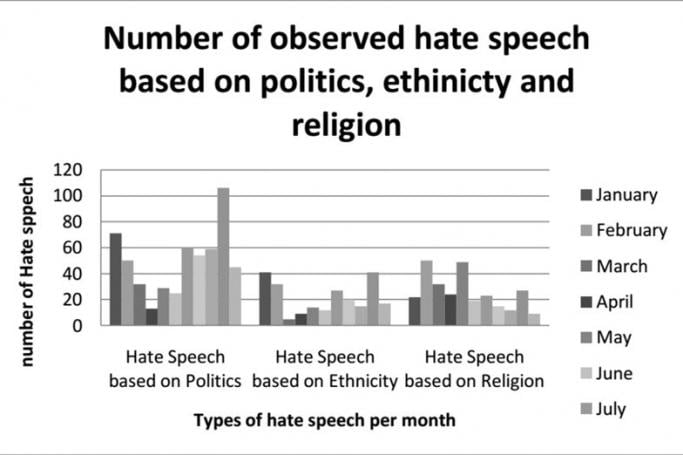To systematically monitor the use of hate speech through media, PEN Myanmar has been conducting a conflict sensitive media monitoring project, the group said in a statement on 12 January to announce the release of their report ‘Hate Speech:A Study of Print, Movies, Songs and Social Media in Myanmar.’
The project focussed on broadcast media (primarily songs and movies), social media (Facebook) and print media (newspapers, journals, and magazines) from January 2015 to 10 November 2015.
Overall, about 153 Facebook pages were monitored on a daily basis (see graphic). During the observation period, the number of accounts had to be increased depending on the political context of the country. At least 60 % of the pages were active.
About 1613 newspapers, magazines and journals were monitored in total, 4 newspapers, namely, the Mirror, 7 Day Daily, Standard Times daily and Myawaddy were observed daily. Weekly journals, namely, The Sun Rays, Myanmar Post, People Age, News Watch and Union journals were observed weekly and one biweekly magazine was observed.
It was noted that most magazines were highly sensitive to conflict and met the standards of conflict sensitive journalism. It was observed that hate speech based on politics is higher than hate speech based on religion for print media, which was contrary to the results found on social media. Comparing hate speech on social media against print media the latter has religious hate speech. However, political hate speech was obvious in print media and other types of media.
Additionally, about 269 songs were monitored in total during the observation period. Of the number of songs observed about 93 contained hate speech. Songs disseminated through YouTube included more hate speech than songs on Broadcast media. Among the observed songs, hate speech based on politics and ethnicity could be found as well as religion.
Movies, especially action movies included several hate speech messages against foreigners and people with diverse political ideologies. Among the observed movies, hate speech based on politics and ethnicity could be found, however, it was very rare for hate speech based on religion, the report said.
The report also made a number of recommendations saying the government should promote public awareness of the nature of conflict and conflict resolution; set up obligations of government officials, journalists and citizens to report and distribute news which is true, reliable and not likely to cause panic; strengthen legal rules and regulations on the use of social media in relation to offensive and abusive language.
As far as social media users were concerned the report recommended that users should take conflict sensitive responsibility for putting news, notes and photos on social media and avoid making an opinion into a fact. Meanwhile publishers should attempt to raise public awareness on the consequences of hate speech through print media, practice conflict sensitive journalism, and participate in anti-hate speech campaigns.
You are viewing the old site.
Please update your bookmark to https://eng.mizzima.com.
Mizzima Weekly Magazine Issue...
14 December 2023
Spring Revolution Daily News f...
13 December 2023
New UK Burma sanctions welcome...
13 December 2023
Spring Revolution Daily News f...
12 December 2023
Spring Revolution Daily News f...
11 December 2023
Spring Revolution Daily News f...
08 December 2023
Spring Revolution Daily News f...
07 December 2023
Diaspora journalists increasin...
07 December 2023
Fears about spread of COVID 19 amongst Myanmar migrant












